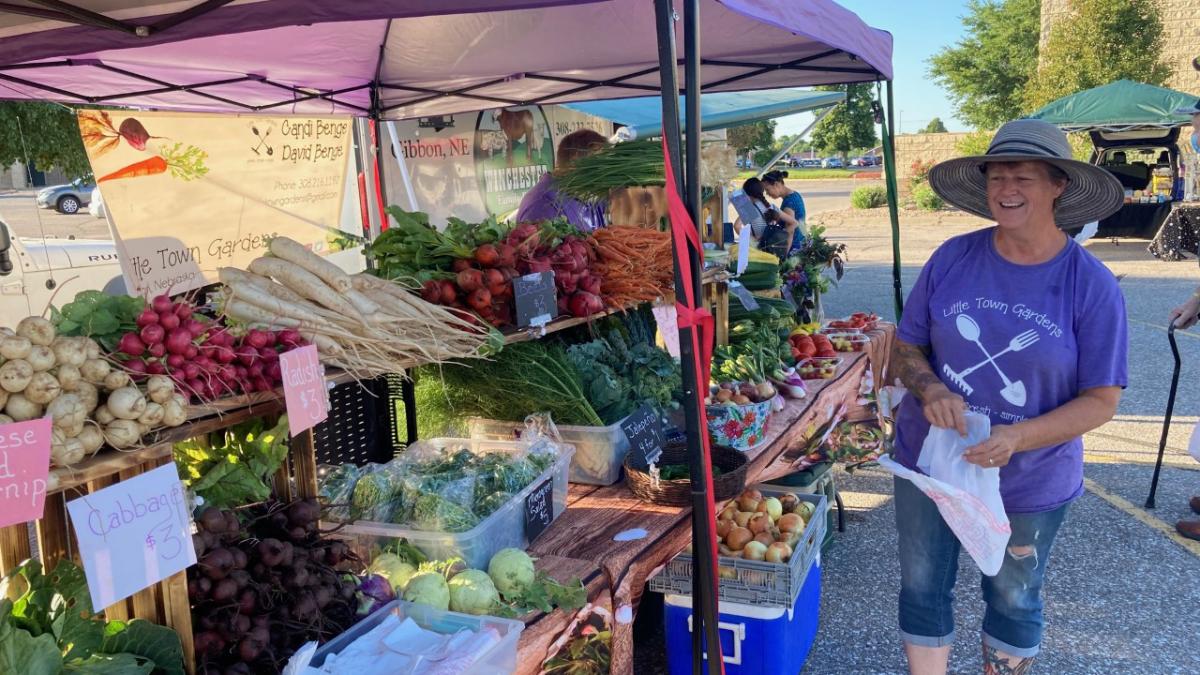Buy Fresh Buy Local.
Rural farmers markets are valuable community assets that generate local economic activity, engage residents in important social and civic activity and contribute to the vitality of rural communities. Many beginning producers rely on rural direct-to-consumer markets to build their agricultural businesses and develop reliable customer bases. In addition, rural communities benefit in many ways from the presence of a successful farmers market, from increased access to healthy foods for rural residents, entrepreneurial activity, and contributing to retention of families and young people in shrinking towns across the state.
In 2010, there were only 74 farmers markets in Nebraska, with concentrations in urban areas. Today, there are approximately 99 farmers markets in Nebraska (a 35% increase in less than 10 years), 77 of them rural. Rural farmers markets have grown independently across Nebraska, springing up in small towns where groups of committed producers or community members have taken initiative. This rural growth has resulted in a great diversity of market structures, approaches and organization. We know that nearly half of all rural Nebraskans (44%) report getting some of their food from farmers markets or CSAs, indicating strong demand for direct-to-consumer options.
Though there might be strong demand, small rural farmers markets are not always accessible to all customers. They may be poorly advertised, such that only a subset of community members knows where to find them. They may not accept credit or debit, limiting payment methods. In addition, because only one rural market in Nebraska accept SNAP/EBT, and just 31 accept Senior Farmers Market Nutrition Program vouchers (SFMNP), access to and affordability of farmers market purchases are increasingly out of reach for low-income rural residents.
In communities with high minority populations, markets often lack bilingual signage or other intercultural approaches that can welcome all customers. This lack of accommodation for non-English speaking residents contributes to a general feeling of being unwelcomed in their communities. As demographics continue to shift across rural Nebraska — from 2010-2017 nearly 50,000 Hispanic/Latino immigrants came to Nebraska, many of them seeking work in rural communities (U.S. Census Bureau, 2013-2017 American Community Survey 5-Year Estimates) — it has become increasingly important that farmers markets take new approaches to reach local customers.
Through a USDA Farmers’ Market Promotion Program grant, Nebraska Extension, Buy Fresh Buy Local Nebraska and The Center for Rural Affairs are working to support the resilience and accessibility of rural markets in Nebraska. The Go-To-Grow/Vamos Apoyar project is a collaborative effort between partner organizations and rural farmers’ market managers and vendors. The project seeks to strengthen rural farmers’ markets in three main areas:
- Provide training and support to enable farmers market managers and vendors to use best practices for direct farmers market sales to rural customers.
- Increase access to rural markets for traditionally underserved audiences in rural communities (i.e. seniors, Latinos, immigrant populations and SNAP customers) through targeted outreach and training.
- Raise statewide public awareness of and interest in farmers markets through a coordinated marketing and promotion campaign.
Created in 2019, the Nebraska Go to Grow/Vamos Apoyar project has developed relationships with dozens of rural markets, facilitated virtual trainings for rural farmers’ market vendors and organizers, implemented a successful print and digital media marketing campaign, provided technical assistance to established and developing markets and created bilingual market signage. In the coming year, the Go to Grow/Vamos Apoyar project will complete a rural farmers market handbook for market organizers and vendors, a valuable resource for market organizers in the state. A new interactive map, found online at gotogrow.org, allows Nebraskans to find details on farmers markets in communities across the state. A Spanish-language version website is available at vamosapoyar.org.
The COVID-19 pandemic has highlighted the importance of farmers’ markets to our domestic food supply, and to our communities’ health and wellbeing. In 2020, Nebraska markets pivoted rapidly to ensure that markets would stay open to the public by increasing online sales, adding safety precautions into their operations, and eliminating non-essential activities like music and kids’ events. Those efforts, coupled with decreased attendance in 2020, have had a significant impact on Nebraska markets. Nationally, the pandemic strained farmers market organizations to keep markets open; 93% of markets reported added costs to operate while 74% reported decreased income.
In 2021, Nebraskans all over the state can support their farmers’ markets by grabbing their shopping bags and heading to the nearest market. Nebraska’s 99 registered farmers markets provide access to healthy, locally produced food no matter where you live. Visit gotogrow.org or vamosapoyar.org to find a farmers market near you.


